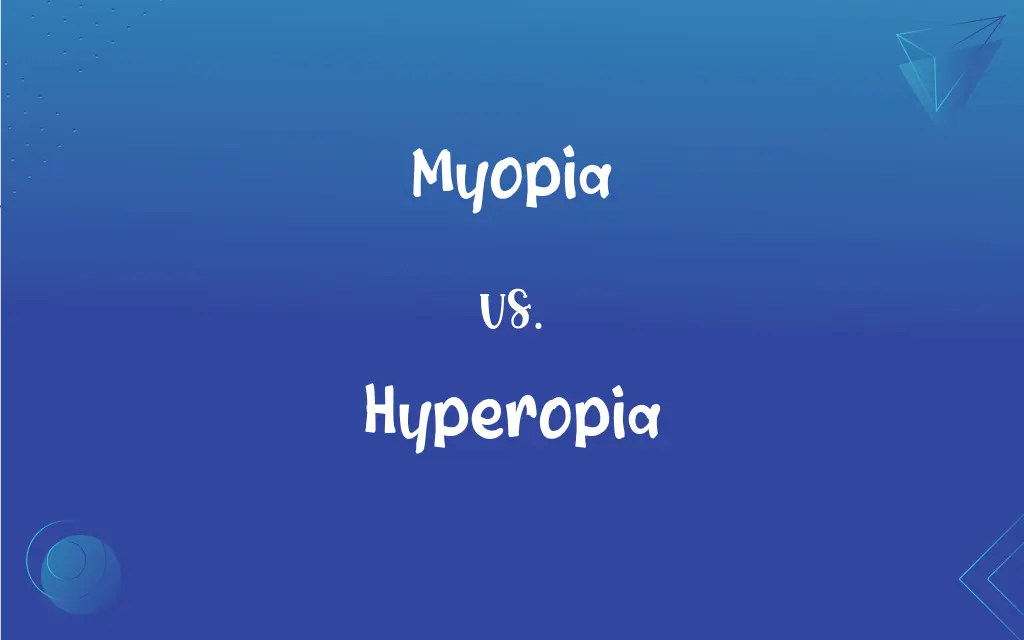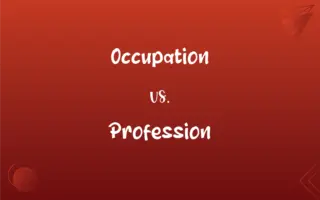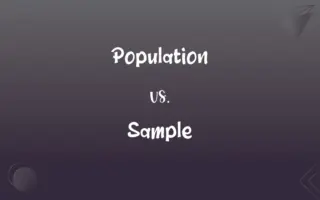Myopia vs. Hyperopia: What's the Difference?
Edited by Aimie Carlson || By Harlon Moss || Updated on October 29, 2023
Myopia, or nearsightedness, is difficulty seeing distant objects; hyperopia, or farsightedness, is trouble seeing close objects.

Key Differences
Myopia and hyperopia are two common refractive errors of the eye, each resulting in different visual impairments. In myopia, often referred to as nearsightedness, distant objects appear blurry while close objects can be seen more clearly. Conversely, in hyperopia, or farsightedness, close objects appear blurry while distant objects might be clearer. These conditions arise due to the way light rays are bent or refracted as they enter the eye and focus on the retina.
The physical structure of the eyeball plays a significant role in determining whether an individual has myopia or hyperopia. In the case of myopia, the eyeball is typically longer than usual, or the cornea has an excessive curvature. This causes light rays to focus in front of the retina instead of on it. On the other hand, hyperopia is often caused by a shorter than average eyeball or a flatter cornea. In this scenario, light focuses behind the retina, making it difficult to see nearby objects distinctly.
Both myopia and hyperopia can be present from birth, but they can also develop or change over time. Myopia often starts in childhood and may continue to increase until the individual reaches young adulthood. It's not uncommon for school-age children to develop myopia if they engage in extensive close-up activities like reading or using computers. Hyperopia, while also present in some children, often becomes more noticeable in adults over the age of 40, when the ability to focus on close objects diminishes, a condition called presbyopia.
To correct the vision problems caused by myopia and hyperopia, various optical solutions are available. Myopia is usually corrected using concave lenses, which help to spread out light rays, ensuring they focus on the retina. For hyperopia, convex lenses are employed to converge the light rays and shift the focal point forward onto the retina. Whether it's through eyeglasses, contact lenses, or surgical interventions, both conditions are treatable, and individuals can achieve clearer vision.
Regular eye examinations are crucial for detecting and managing conditions like myopia and hyperopia. While both conditions manifest with blurriness at different distances, other symptoms like eyestrain, headaches, or the need to squint might also be indications of these refractive errors. Early detection of myopia or hyperopia can lead to more effective interventions, ensuring better visual health and quality of life for affected individuals.
ADVERTISEMENT
Comparison Chart
Definition
Difficulty seeing distant objects.
Difficulty seeing close objects.
Light Focus
In front of the retina.
Behind the retina.
Common Age of Onset
Childhood or adolescence.
Any age, more noticeable in adults.
Typical Correction Needed
Glasses for distance vision.
Glasses for near vision.
Anatomical Cause
Longer eyeball, steep cornea.
Shorter eyeball, flat cornea.
ADVERTISEMENT
Myopia and Hyperopia Definitions
Myopia
A vision condition causing distant objects to appear blurry.
Her myopia made it hard to see the board at school.
Hyperopia
A vision condition causing difficulty seeing close objects clearly.
His hyperopia made reading small print a challenge.
Myopia
Caused by an elongated eyeball or excessive curvature of the cornea.
Myopia in her case was due to a longer-than-average eyeball.
Hyperopia
Light rays focus behind the retina.
Her hyperopia caused images to focus beyond the retina.
Myopia
Correctable with glasses, contact lenses, or refractive surgery.
He used glasses to correct his myopia.
Hyperopia
Can be corrected with glasses, contact lenses, or refractive surgery.
She chose contact lenses to correct her hyperopia.
Myopia
Also known as nearsightedness.
With myopia, he couldn't see the street signs clearly.
Hyperopia
Also known as farsightedness.
Due to her hyperopia, she needed reading glasses.
Myopia
Light rays focus in front of the retina.
In her myopia, images focused before reaching the retina.
Hyperopia
Results from a shorter eyeball or a cornea with too little curvature.
Hyperopia in his case was attributed to a flatter cornea.
Myopia
A visual defect in which distant objects appear blurred because their images are focused in front of the retina rather than on it. Also called nearsightedness, short sight.
Hyperopia
An abnormal condition of the eye in which vision is better for distant objects than for near objects. It results from the eyeball being too short from front to back, causing images to be focused behind the retina. Also called farsightedness, hypermetropia.
Hyperopia
(pathology) A disorder of the vision where the eye focusses images behind the retina instead of on it, so that distant objects can be seen better than near objects.
Hyperopia
An abnormal condition of the eye in which, through shortness of the eyeball or fault of the refractive media, the rays of light come to a focus behind the retina, making vision for distant objects better than for near objects; farsightedness; - called also hypermetropia. Cf. Emmetropia.
Hyperopia
Abnormal condition in which vision for distant objects is better than for near objects
FAQs
What is myopia?
Myopia, or nearsightedness, is a condition where distant objects appear blurry.
Can hyperopia be treated?
Yes, hyperopia can be treated with glasses, contacts, or surgery.
What is hyperopia?
Hyperopia, or farsightedness, is a condition where close objects appear blurry.
How is myopia corrected?
Myopia is corrected with glasses, contact lenses, or refractive surgery.
Can myopia lead to other eye problems?
High myopia increases the risk of conditions like retinal detachment.
How is hyperopia detected?
Hyperopia is detected through a standard eye examination.
Can hyperopia improve naturally?
In some children, mild hyperopia can improve as the eye grows.
Is myopia more common than hyperopia?
Myopia is generally more prevalent, especially in younger populations.
Can outdoor activities reduce the risk of myopia?
Regular outdoor activities are associated with a reduced risk of myopia.
Are contact lenses a good option for hyperopia?
Yes, contact lenses can effectively correct hyperopia.
Is myopia genetic?
Yes, myopia often has a genetic component.
Can hyperopia lead to headaches?
Yes, straining to see clearly can cause headaches in hyperopia.
Is reading difficulty a sign of hyperopia?
Yes, difficulty in reading or doing close work can indicate hyperopia.
Can hyperopia affect both eyes equally?
Hyperopia often affects both eyes, but the degree can vary between eyes.
Can lifestyle affect myopia?
Yes, factors like excessive screen time can contribute to myopia development.
Can myopia stabilize over time?
Yes, myopia often stabilizes in early adulthood.
Is laser surgery an option for myopia?
Yes, laser surgery is often used to correct myopia.
Does hyperopia worsen with age?
Hyperopia can become more noticeable with age, especially after 40.
Is hyperopia common in children?
Some children are born with hyperopia, but it may not be noticeable until later.
Do people with myopia see well up close?
Yes, individuals with myopia usually see well up close.
About Author
Written by
Harlon MossHarlon is a seasoned quality moderator and accomplished content writer for Difference Wiki. An alumnus of the prestigious University of California, he earned his degree in Computer Science. Leveraging his academic background, Harlon brings a meticulous and informed perspective to his work, ensuring content accuracy and excellence.
Edited by
Aimie CarlsonAimie Carlson, holding a master's degree in English literature, is a fervent English language enthusiast. She lends her writing talents to Difference Wiki, a prominent website that specializes in comparisons, offering readers insightful analyses that both captivate and inform.






































































